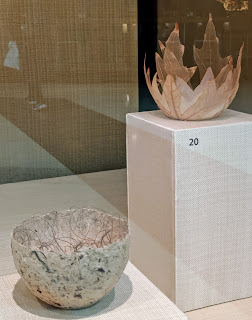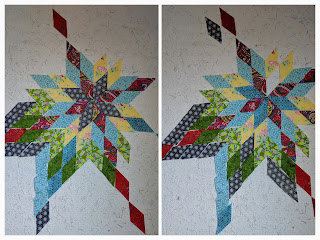 |
| Lone Star quilt 5 |
Here's how I started the center. I thought the green would work but it wasn't strong enough. The navy blue print is better.
Next I tried moving the reds. Across the star points or down them? Should the outer row be green or navy or alternate?
Or perhaps it should be navy and light blue. Do the inside of the star points look better with dark or light greens and blues? Taking photos helps decide which looks best. Aren't we lucky to live in the digital era!
Finally I tested several borders. Of course, that blue with the green print border was my favorite but there's not enough. And this quilt is for a girl. The pink is a shocker but in a good way.
 |
| Possible borders for Lone Star quilt 5 |
Again I started this spiral with orange peel arcs in the center of the star then completed a circle around them. After that, a quick off-ramp starts the spiral.
 |
| Quilting detail |
Here's a view of the back. The quilting doesn't show up as much on this print as it did on the solid of the previous quilt but it works well with the greens on the front. A navy print finished the binding.
 |
| Detail of front, back, and binding of Lone Star quilt 7 |
Done and dusted. Who'd have thought? But now DH will think I can pull this off any time.
Quilt Details
Size: 40" x 40"
Design: Lone Star
Batting: Pellon 100% cotton
Thread: Metler fine embroidery pink cotton
Quilting: Spiral with walking foot
Approximate Yardage: 3.75 yd
The next day I flew out to see my daughter. SFO has wonderful exhibits in their terminals. This time they displayed California Studio Craft from the Forrest Merrill collection featuring work from the 1940s to the present including sculpture, pottery, paintings, textiles, and furniture. Studio craft combines handmade crafting with fine art. Precursors to the American Craft Council and the NYC Museum of Arts and Design raised the professionalism of the artists and increased the popularity of the movement which really took off after WWII with the use of the GI Bill.
 |
| Bowl and Tile by Beatrice Wood, 1940s |
The graceful lines of the legs attracted me. I wonder if it's as comfortable as it looks.
 |
| Hammered and soldered copper Sixes by Merry Rink (1976) with shedua and leather Wishbone chair by Arthur E Carpenter (1972) |
Mr. Merrill collected at least two artists' work over the years. The exhibit highlighted how each worked on a simple design in series. First, John Lewis created lunar themes with his glassworks.
 |
| Blown glass Moon Bottle (1970) and Moon Bowl (1972) by John Lewis |
 |
| Bowl and Leaf bowl by Kay Sekimachi |
Intricate woven, embroidered, and silkscreened textiles were tucked into the corner where the curving glass picked up all the reflected lights making photos impossible.
FUR or Fabric Use Rate Update
I donated 8.25 yards to the guild this month and finished two baby quilts of 3.75 yards each so my total FUR is 15.75 yards/month or a smidge over half a yard per day. That's something to consider before I go shopping again.
Enjoy the day, Ann


